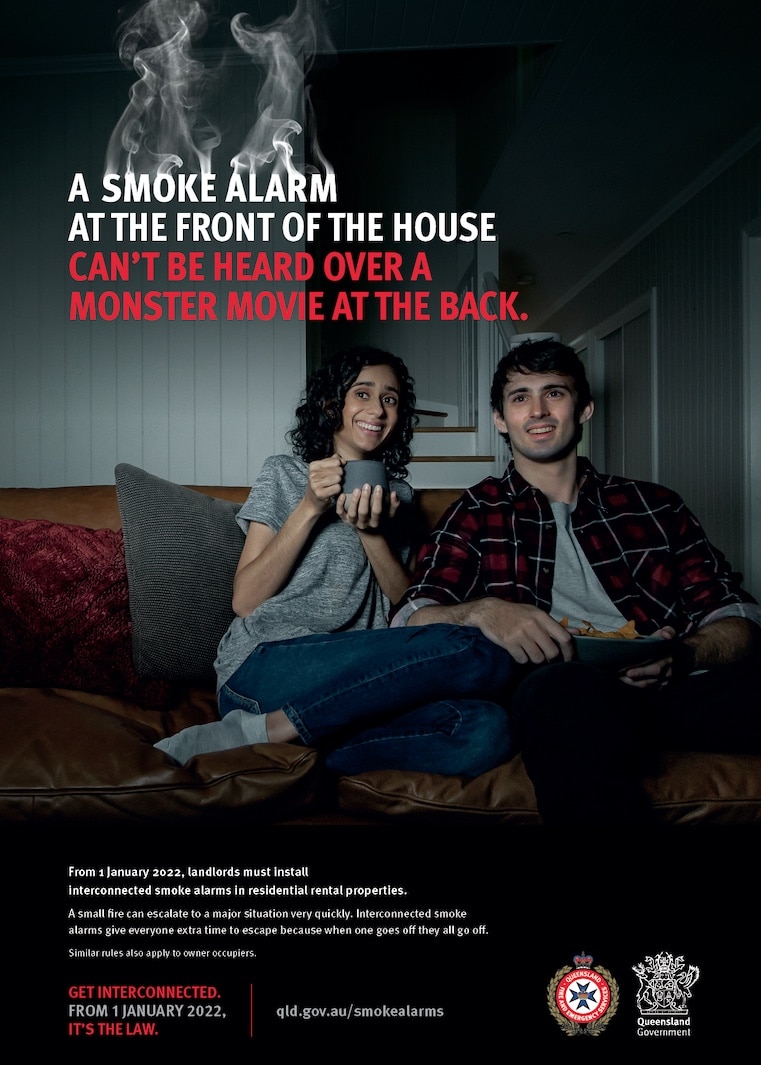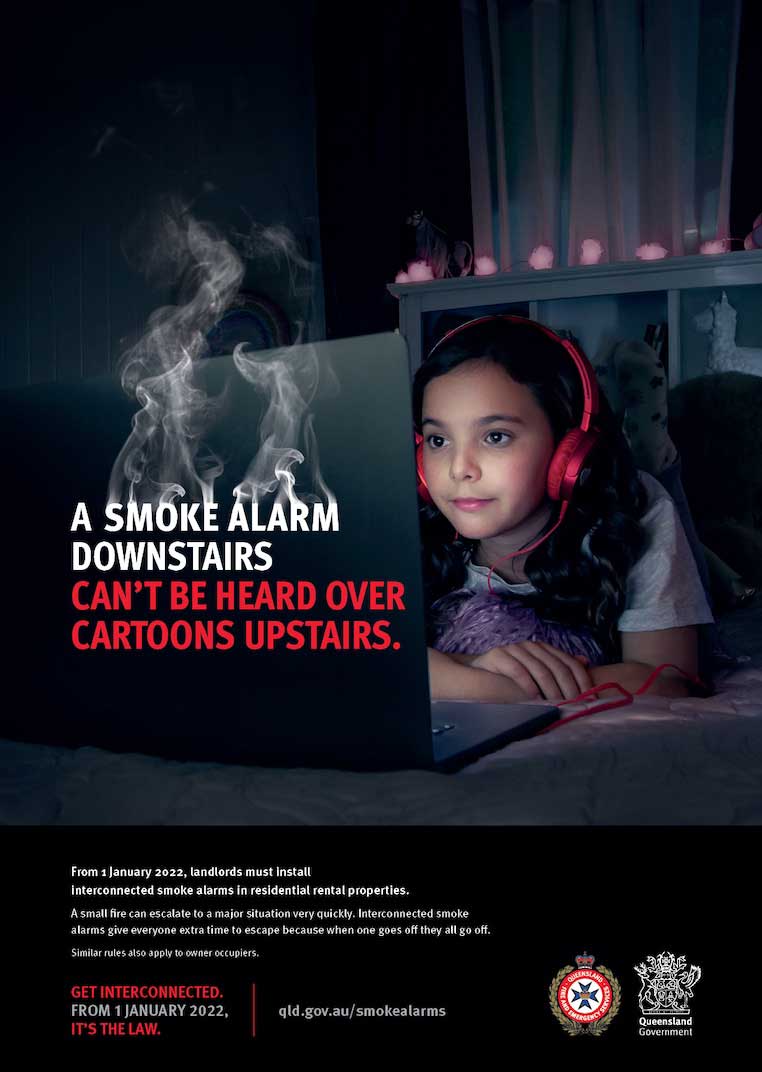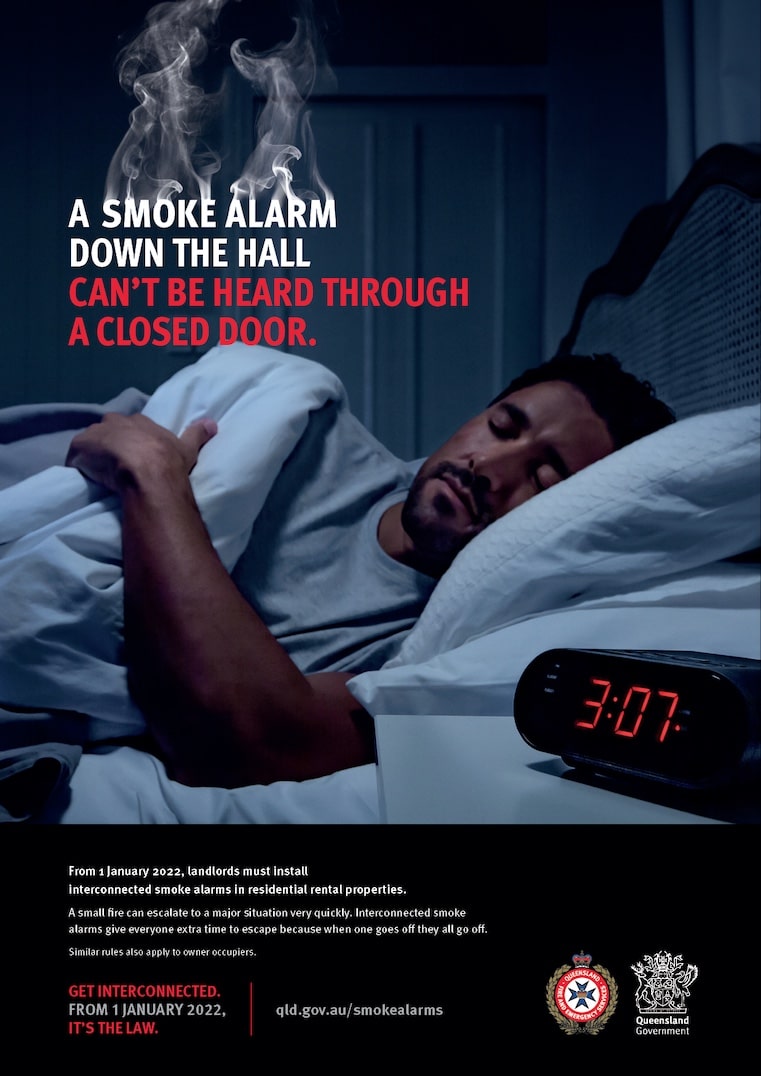Smoke alarms
There is new legislation stating that from the 1st of January 2022, all owners of residential rental properties must ensure that interconnected photoelectric smoke alarms are installed in every tenanted property. The advantage of this type of alarm system is that if a single alarm goes off, every other alarm will sound as well. Giving occupants ample time to escape to safety.
All other dwellings such as owner occupied homes will need to comply fully with this new legislation by 2027.
Everyone is encouraged not to hesitate in implementing the change set out in the new legislation as It is solely focused on your safety and that of others.
What is expected of landlords?
It’s the responsibility of all landlords to ensure smoke alarms compliant with the new Smoke Alarm legislation be installed in all of their rental properties prior to the 1st of January 2022.
Interconnected photoelectric smoke alarms compliant with Australian Standard 3786-2014 must replace any smoke alarm in operation that was produced more than 10 years ago and replace any smoke alarm that’s not functional when tested.

Landlords and renters
At a minimum tenants should press the “test” button on the smoke alarm to see if it is functioning. As well as cleaning following the instruction manual – the procedure is typically to vacuum the unit.
Outsourcing smoke alarm maintenance to companies specialising in smoke farm instillation and maintenance provides the greatest peace of mind to all interested parties and ensures compliance with government legislation. It is the landlords responsibly to pay for any such service. A certificate of compliance should be issued by the company undertaking the work and issued to the landlord or real estate agent to confirm the service has been rendered.
What is expected for existing buildings?
Starting the 1st of January, 2022
- Photoelectric interconnected smoke alarms will be required in every existing unit, townhouse and private building offered for rent or sale. These alarms must be either hardwired or have a built-in 10 years battery capacity.
- Following legislation, installation of smoke alarms is mandatory in the following places:
- Each bedroom
- On every level
- Hallways linking bedrooms and other parts of the house
- Between bedrooms and the rest of the level should there be no hallway
- On the way out of the building a minimum of one smoke alarm must be fitted where there are no bedrooms on that level.
What is expected of new buildings and buildings under renovation from the 1st of January, 2022
The National Construction Code (NCC) which is formally known as Building Code of Australia (BCA) and the Building Regulation 2006 stipulates that all homes, both new and under renovation, should have the required smoke alarms installed. It’s part of the building approval process.
What is required?
- It’s mandatory that the smoke alarm system in the building:
- Be a photoelectric type and comply with AS3786-2014
- Not carry an ionisation sensor
- Be connected to the primary power source via hardwiring or have a 10 year inbuilt source of power – battery
- Be interconnected with all other required smoke alarms in the building for collective activation.
- Following the legislation, installation of smoke alarms is mandatory in the following places:
- Each bedroom
- Every level
- Hallways linking bedrooms and other parts of the house
- Between the bedrooms and the rest of the level should there be no hallway
- On the way out of the building a minimum of one smoke alarm must be fitted where there are no bedrooms on that level
- Smoke alarms must be powered via hardwiring, or powered by an inbuilt 10-year battery
- An effective escape plan in case of a fire outbreak should be developed to ensure everybody gets out unhurt.

Technical details
What are the legal requirements?
It’s mandatory that a rented properties smoke alarms:
- Be photoelectric and be compliant with Australian Standard 3786-2014
- Not contain an ionisation sensor
- Be below 10 years of age
- Work when tested
- Be interconnected with all other required smoke alarms in the building for collective activation
Buying advice
The smoke alarm unit you’ll buy must be designated with AS3786-2014 to ensure compliance.
What you shouldn’t buy
Non-photoelectric smoke alarms should be avoided.
Where exactly should they be fitted?
In cases where possible, smoke alarms must be installed on the ceiling.
They shouldn’t be installed within:
- 300mm of a light fitting
- 300mm of a wall and ceiling corner
- 400mm of an air-conditioning vent
- 400mm of a ceiling fan blades
Sloping ceilings, stairways and ceilings having exposed beams have special requirements.
Dead air spaces are a no-no for smoke alarm installation. Here, the hot air that’s trapped won’t allow the smoke get to the alarm. These spaces are found between exposed floor joists and peak of cathedral ceilings.
Avoiding nuisance alarms
Buildings are not the same. It is vital to know the type of building you have. Ensure not to fit smoke alarms close to air conditioners, fans, doors and windows. Too much air movement cause nuisance alarms and may also not allow gases and smoke to get to the alarm unit in the event of a fire.
Alarms that often set off accidentally constitute a nuisance. These nuisances become dangerous if home owners or tenants disable an alarm or entire system to make the alarm mute.
You can avoid nuisance alarms by not installing alarms in or close to kitchens as cooking smoke can activate them, or in or close to bathrooms as steam can also trigger false alarm.
Other areas where there’s an infestation of insects can also set off an alarm and should be avoided or treated.

FAQ's
Who is affected by the new legislation?
Class 1a buildings like houses or townhouses and class 2 buildings like apartments or units are affected. Dwellings of short-term occupancy like caravans, motels, dormitories or other buildings are not affected. They fall under the National Construction Code (NCC) requirement.
I am currently building my house/unit; does the legislation affect me?
Where should smoke alarms be installed?
- Each bedroom
- Each storey
- Hallways linking bedrooms and other parts of the house
- Between the bedrooms and the rest of the storey should there be no hallway
- On the way out of the building a minimum of one smoke alarm must be fitted where there are no bedrooms on a storey
Do I need to effect any changes now?
- Smoke alarms older than 10 years or not working when tested must be replaced
- Every replacement must be a photoelectric smoke alarm compliant with AS3786-2014 and powered by the same voltage rating. For instance, if the previous power rating was 240v, the same rating should be maintained, or it can be powered by an inbuilt 10 year battery.
- Every smoke alarm required by legislation must upon replacement be switched with AS3786-2014 compliant smoke alarms.
At what time should I install and interconnect more smoke alarms?
- For buildings for lease, re-lease or sale, the start date is 1 January, 2022
- For all other buildings, the start date is 1 January, 2027
- All smoke alarms fitted after these dates need to be powered by a 240v hardwired power source or an inbuilt 10-year battery and they must be interconnected to every other required smoke alarms in the building via wires or through wireless connection. Note that all smoke alarms required by legislation must meet the AS3786-2014 requirement.
At Smoke Alarm Compliance QLD we also only use top quality alarms. All our smoke alarms come with a full 10 year warranty guaranteeing the smoke alarms for their entire life. Unlike other brands, you will never have to pay for replacing a faulty smoke alarm in the next 10 years!
Add to this our fixed pricing structure meaning there are no hidden surprises or unwelcome bills at the end of the job why would you choose anyone else.
Brochure Request
